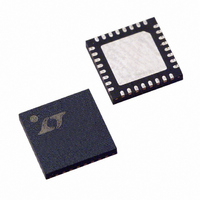LTC1628CUH Linear Technology, LTC1628CUH Datasheet - Page 20

LTC1628CUH
Manufacturer Part Number
LTC1628CUH
Description
IC SW REG STP-DN 2PHS 32QFN
Manufacturer
Linear Technology
Type
Step-Down (Buck)r
Datasheet
1.LTC1628CGPBF.pdf
(32 pages)
Specifications of LTC1628CUH
Internal Switch(s)
No
Synchronous Rectifier
Yes
Number Of Outputs
2
Voltage - Output
Adj to 0.8V
Current - Output
3A
Frequency - Switching
220kHz
Voltage - Input
3.5 ~ 30 V
Operating Temperature
0°C ~ 85°C
Mounting Type
Surface Mount
Package / Case
32-QFN
Lead Free Status / RoHS Status
Contains lead / RoHS non-compliant
Power - Output
-
Available stocks
Company
Part Number
Manufacturer
Quantity
Price
Company:
Part Number:
LTC1628CUH
Manufacturer:
Linear Technology
Quantity:
135
Company:
Part Number:
LTC1628CUH
Manufacturer:
LT
Quantity:
10 000
Part Number:
LTC1628CUH#PBF
Manufacturer:
LINEAR/凌特
Quantity:
20 000
APPLICATIO S I FOR ATIO
LTC1628/LTC1628-PG
Fault Conditions: Overcurrent Latchoff
The RUN/SS pins also provide the ability to latch off the
controller(s) when an overcurrent condition is detected.
The RUN/SS capacitor, C
limit the inrush current. After the controller has been
started and been given adequate time to charge up the
output capacitor and provide full load current, the RUN/SS
capacitor is used for a short-circuit timer. If the regulator’s
output voltage falls to less than 70% of its nominal value
after C
assumption that the output is in an overcurrent condition.
If the condition lasts for a long enough period as deter-
mined by the size of the C
current, the controller will be shut down until the RUN/SS
pin voltage is recycled. If the overload occurs during start-
up, the time can be approximated by:
If the overload occurs after start-up the voltage on C
begin discharging from the zener clamp voltage:
The FLTCPL pin (LTC1628 only) determines whether an
overload on one channel will latch off only that channel
(FLTCPL = 0V) or both channels (FLTCPL = INTV
built-in overcurrent latchoff can be overridden by provid-
ing a pull-up resistor to the RUN/SS pin as shown in
Figure 7. This resistance shortens the soft-start period
and prevents the discharge of the RUN/SS capacitor
during an over current condition. Tying this pull-up resis-
tor to V
Diode-connecting this pull-up resistor to INTV
Figure 7b, eliminates any extra supply current during
controller shutdown while eliminating the INTV
from preventing controller start-up.
Why should you defeat overcurrent latchoff? During the
prototyping stage of a design, there may be a problem
with noise pickup or poor layout causing the protection
circuit to latch off. Defeating this feature will easily allow
troubleshooting of the circuit and PC layout. The internal
20
t
t
LO1
LO2
SS
= 2.7 • 10
IN
[C
reaches 4.1V, C
[C
as in Figure 7a, defeats overcurrent latchoff.
SS
SS
(6 – 3.5)]/(1.2 A) = 2.1 • 10
(4.1 – 1.5 + 4.1 – 3.5)]/(1.2 A)
6
U
(C
SS
)
SS
U
SS
SS
, is used initially to turn on and
and the specified discharge
begins discharging on the
W
6
(C
U
CC
SS
CC
CC
)
loading
). This
, as in
SS
will
short-circuit and foldback current limiting still remains
active, thereby protecting the power supply system from
failure. After the design is complete, a decision can be
made whether to enable the latchoff feature.
The value of the soft-start capacitor C
scaled with output voltage, output capacitance and load
current characteristics. The minimum soft-start capaci-
tance is given by:
The minimum recommended soft-start capacitor of
C
Fault Conditions: Current Limit and Current Foldback
The LTC1628 current comparator has a maximum sense
voltage of 75mV resulting in a maximum MOSFET current
of 75mV/R
generally occurs with the largest V
ent temperature, conditions that cause the highest power
dissipation in the top MOSFET.
The LTC1628 includes current foldback to help further
limit load current when the output is shorted to ground.
The foldback circuit is active even when the overload
shutdown latch described above is overridden. If the
output falls below 70% of its nominal output level, then the
maximum sense voltage is progressively lowered from
75mV to 25mV. Under short-circuit conditions with very
low duty cycles, the LTC1628 will begin cycle skipping in
order to limit the short-circuit current. In this situation the
bottom MOSFET will be dissipating most of the power but
less than in normal operation. The short-circuit ripple
current is determined by the minimum on-time t
the LTC1628 (less than 200ns), the input voltage and
inductor value:
The resulting short-circuit current is:
SS
C
I
SC
SS
= 0.1 F will be sufficient for most applications.
I
L(SC)
> (C
R
25
= t
SENSE
OUT
SENSE
mV
ON(MIN)
)(V
. The maximum value of current limit
OUT
2
1
(V
) (10
I
IN
L SC
(
/L)
– 4
)
) (R
SENSE
IN
at the highest ambi-
SS
)
may need to be
ON(MIN)
1628fb
of














